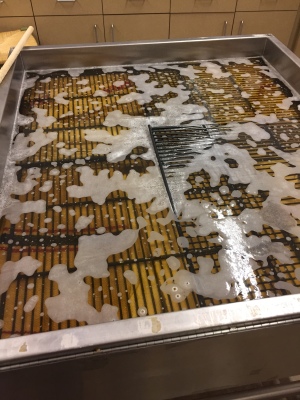Sometimes I forget my own rules. Usually it’s intentional when I am in an improvisational mood. Sometimes, I am lazy and just don’t want to go find something or go to the store. Sometimes I’m just not thinking. Brains are in our heads for a reason! We should always use them.
Last night as I was cutting just two layers of fabric and my rotary blade was requiring a lot of pressure and making a loud noise as I was cutting. It was taking forever to cut the fabric. I was only about 10% of the way through all I needed to cut. Hubby came in the room and blurted out, “wow, that’s loud! How tough is that fabric?”
I set the cutter down and slapped my forehead. DUH!
Usually I have to change the rotary blades because I nick them and they don’t cleanly cut. Apparently this blade was immune to my propensity to leave needles in fabric and escaped the usual nicks. It was cutting cleanly so it didn’t occur to me that the blade was dull.
Changed the blade and was able to stack my fabric in five layers and cut the last 90% in half the time it took to do the first bit. And, it cut like butter.
The really interesting part was… after cutting I looked at my cutting mat. The dull blade made deeper wider grooves than the sharp blade. Good cutting mats are expensive.
Moral relearned: sharper cutting blades (scissors, knives, blades) are better! Safer! More accurate! And save money!







 Always check the sizes of fabric, always! Even when a the charity coordinator says it is all measured and ready. Even when the first three quilt tops and backs you did were correctly sized for longarming. Always check! Grrrrr!
Always check the sizes of fabric, always! Even when a the charity coordinator says it is all measured and ready. Even when the first three quilt tops and backs you did were correctly sized for longarming. Always check! Grrrrr!






